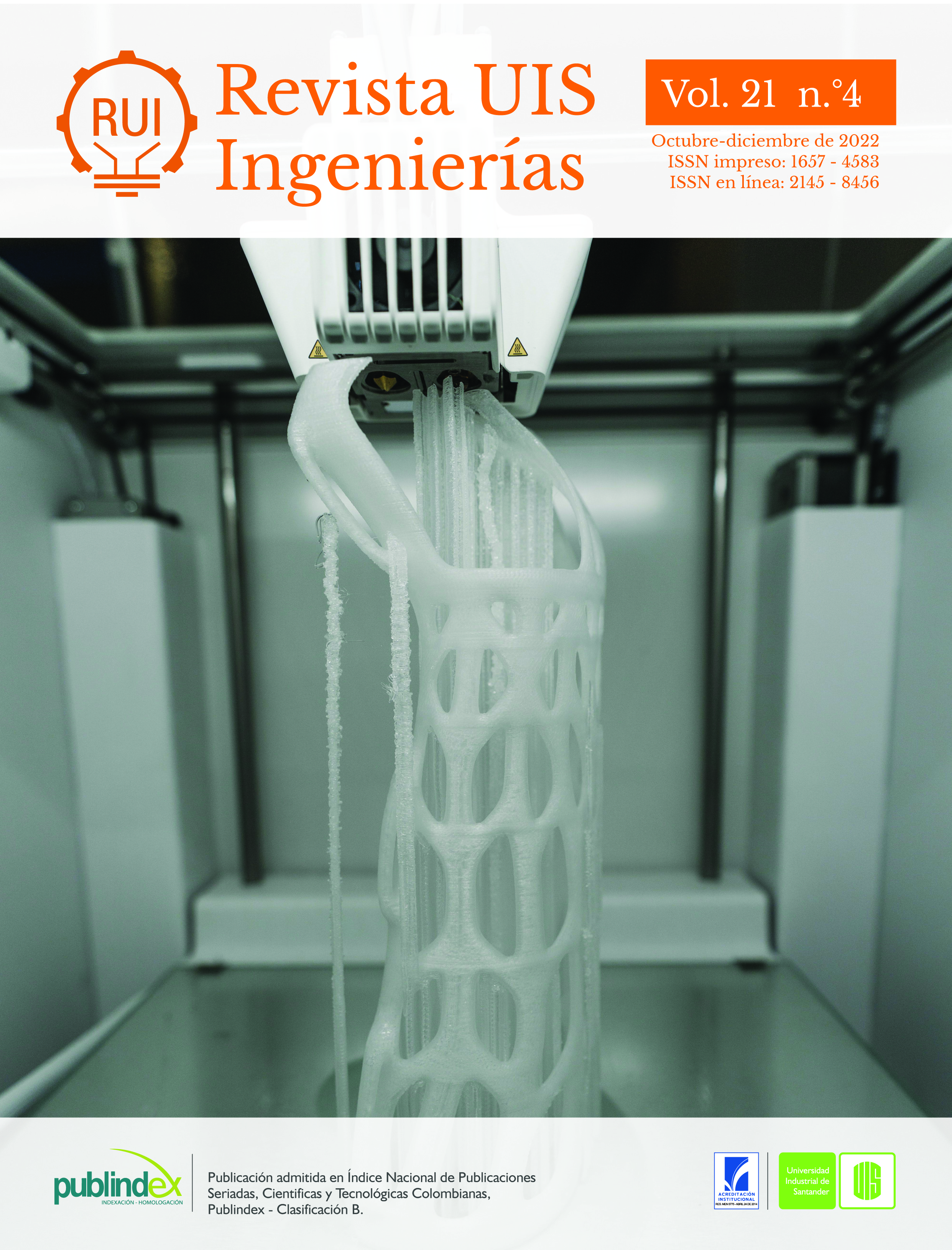Modelado de convertidores híbridos Cuk utilizando la metodología de referencias de tensión y corriente
Publicado 2022-10-30
Palabras clave
- convertidores híbridos Cuk,
- dispositivos de electrónica de potencia (EP),
- ecuaciones diferenciales,
- OpenModelica,
- referencias de tensión y corriente
- capacitor,
- inductor,
- interruptor de potencia,
- diodo ...Más
Cómo citar
Derechos de autor 2022 Revista UIS Ingenierías

Esta obra está bajo una licencia internacional Creative Commons Atribución-SinDerivadas 4.0.
Resumen
Este artículo presenta una metodología para la obtención de las referencias de tensión y corriente que permiten el modelado de convertidores híbridos Cuk (HC). Se utiliza la convención pasiva de signos cuando los elementos del sistema absorben energía para deducir las ecuaciones diferenciales que rijen el comportamiento del convertidor. Esto permite la explicación del principio de funcionamiento del convertidor que se realiza a través de los estados de conmutación. Se estudia el comportamiento del convertidor mediante un análisis de intercambio de energía entre bobinas y condensadores. Luego de la deducción de las referencias y principio de funcionamiento, se deducen las ecuaciones diferenciales que permiten el modelado del convertidor. Finalmente, se realiza una comparación entre el modelo matemático y la representación circuital del convertidor en OpenModelica con el objetivo de validar las ecuaciones. Los resultados de las simulaciones permiten concluir que las referencias y ecuaciones diferenciales obtenidas son coherentes con la implementación circuital.
Descargas
Referencias
- Z. Bi, W. Xia, “Modeling and simulation of dual-mode DC/DC buck converter,” in ICCMS 2010 - 2010 International Conference on Computer Modeling and Simulation, vol. 3, pp. 371–375, 2010, doi: http://doi.org.10.1109/ICCMS.2010.490
- E. Arango, C. Ramos-Paja, J. Calvente, R. Giral, S. Serna-Garces, “Asymmetrical Interleaved DC/DC Switching Converters for Photovoltaic and Fuel Cell Applications—Part 2: Control-Oriented Models,” Energies, vol. 6, no. 10, pp. 5570–5596, 2013, doi: http://doi.org.10.3390/en6105570
- J.-H. Urrea-Quintero, N. Muñoz-Galeano, L. M. Gómez-Echavarría, “Analysis and Control of Power Electronic Converters Based on a System Zero Locations Approach,” in Applied Modern Control, IntechOpen, 2019.
- T.-D. Duong, M.-K. Nguyen, T. T. Tran, Y. C. Lim, J.-H. Choi, “Transformerless High Step-Up DC-DC Converters with Switched-Capacitor Network,” Electronics, vol. 8, no. 12, p. 1420, 2019, doi: http://doi.org.10.3390/electronics8121420
- M. S. Martínez-García, A. de Castro, A. Sanchez, J. Garrido, “Analysis of Resolution in Feedback Signals for Hardware-in-the-Loop Models of Power Converters,” Electronics, vol. 8, no. 12, p. 1527, 2019, doi: http://doi.org.10.3390/electronics8121527
- P. Shaw, “Modelling and analysis of an analogue MPPT‐based PV battery charging system utilising dc–dc boost converter,” IET Renew. Power Gener., vol. 13, no. 11, pp. 1958–1967, 2019, doi: http://doi.org.10.1049/iet-rpg.2018.6273
- Yang, Zhang, Zhang, Tian, Hu, “Control Strategy of Mode Transition with Engine Start in a Plug-in Hybrid Electric Bus,” Energies, vol. 12, no. 15, p. 2989, 2019, doi: http://doi.org.10.3390/en12152989
- J. Liu, J. Hu, L. Xu, “Dynamic Modeling and Analysis of $Z$ Source Converter—Derivation of AC Small Signal Model and Design-Oriented Analysis,” IEEE Trans. Power Electron., vol. 22, no. 5, pp. 1786–1796, 2007, doi: http://doi.org.10.1109/TPEL.2007.904219
- S. Lica, I.-M. Pop-Calimanu, D. Lascu, S. Popescu, M. Tomoroga, A. Ciresan, “A New Hybrid Ćuk Converter,” in 2018 International Symposium on Electronics and Telecommunications (ISETC), pp. 1–4, 2018, doi: http://doi.org.10.1109/ISETC.2018.8583911
- B. Axelrod, Y. Berkovich, A. Ioinovici, “Switched-capacitor (SC)/switched inductor (SL) structures for getting hybrid step-down Cuk/Sepic/Zeta converters,” in 2006 IEEE International Symposium on Circuits and Systems, p. 4, doi: http://doi.org.10.1109/ISCAS.2006.1693770
- C. Restrepo, T. Konjedic, J. Calvente, M. Milanovic, R. Giral, “Fast Transitions Between Current Control Loops of the Coupled-Inductor Buck–Boost DC–DC Switching Converter,” IEEE Trans. Power Electron., vol. 28, no. 8, pp. 3648–3652, 2013, doi: http://doi.org.10.1109/TPEL.2012.2231882
- P. Fritzson et al., “The OpenModelica Integrated Modeling, Simulation, and Optimization Environment,” in Proceedings of the 13th International Modelica Conference, pp. 206–219, 2019, doi: http://doi.org.10.3384/ecp18154206
- A. M. Dizqah, A. Maheri, K. Busawon, P. Fritzson, “Standalone DC microgrids as complementarity dynamical systems: Modeling and applications,” Control Eng. Pract., vol. 35, pp. 102–112, 2015, doi: http://doi.org.10.1016/j.conengprac.2014.10.006
- A. Bartolini, F. Casella, A. Guironnet, “Towards Pan-European Power Grid Modelling in Modelica: Design Principles and a Prototype for a Reference Power System Library,” in Proceedings of the 13th International Modelica Conference, pp. 627–636, doi: http://doi.org.10.3384/ecp19157627
- D. Reid, “DQ rotating frame PI control algorithm for power inverter voltage regulation modelling and simulation using the OpenModelica platform,” in SoutheastCon, pp. 1–4, 2015, doi: http://doi.org.10.1109/SECON.2015.7132896
- M. A. A. Murad, L. Vanfretti, M. Rokonuzzaman, R. A. Tuhin, “Enhancing engineering studies in developing countries using OpenModelica,” in 2017 4th International Conference on Advances in Electrical Engineering (ICAEE), pp. 153–158, 2017, doi: http://doi.org.10.1109/ICAEE.2017.8255345

